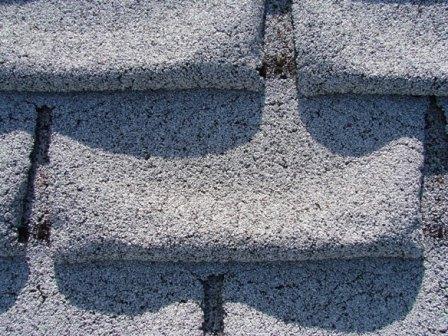Mastering Roof Inspections: Asphalt Composition Shingles, Part 31
by Kenton Shepard and Nick Gromicko, CMI®
Moisture
Moisture can affect shingled roofs in a number of ways, depending on what form the moisture takes. The three different forms of moisture are liquid, solid and vapor (gas). Let’s look at how they can affect asphalt shingles.
- Liquid: In the forms of raindrops and roof runoff, liquids can loosen granules and carry them away. Trapped moisture from precipitation that has found its way beneath the roofing can cause the roof sheathing to decay, weakening its ability to support shingles and hold fasteners. Liquid water that finds its way into a home can cause both cosmetic and structural damage to a variety of materials. Wind-driven rain is a common source of leaks.
- Solid: As ice, moisture can form dams that cause melt-water to back up between shingles, creating leaks. Efforts to remove ice dams may damage shingles.
- Gas: Moisture in its gaseous state is called moisture vapor. Cooking, bathing, washing clothes, and even human respiration all put moisture into the indoor air. All the water used to water plants will eventually wind up in the indoor air. If the water vapor has no good route to the home's exterior, comfort levels and air quality can decline.
Moisture vapor can also enter the home from outside. Inadequate attic or roof venting practices can cause moisture from hot and humid outdoor air to condense on roof framing. This condensate can then be moved into the home by gravity and gradient forces.
Effects of Moisture
Absorption
One of the most important forces through which moisture affects roofs is absorption. Absorption is similar to wicking and capillary action. It’s what happens when a sponge fills with water.
Roof decks expand and contract while absorbing moisture as a liquid or vapor, and then drying. This can lead to buckling or splitting of the shingles.
Shingles may absorb moisture from beneath or from around the edges. This is especially true with organic shingle mats that become more absorbent as they age and lose volatiles. Uneven absorption of moisture can cause shingles to deform in different ways.

“Curling,” “cupping” and “clawing” describe different types of distortion of individual shingles, although most adjacent shingles will be similar in appearance because they have been exposed to similar conditions. The photos below show different examples of organic shingle deformation.






“Alligatoring” and “fishmouth” are general terms that describe extreme distortion of shingles once they’ve reached a stage of advanced deterioration. Although you’ll hear these terms used in the roofing industry, it’s probably best to avoid using them in an inspection report. Most clients will not understand what they mean, and the same is true for attorneys and judges. Most people understand the term “distortion,” so you’ll communicate more effectively by describing the shingles as showing minor, moderate or extreme distortion. You should mention that distortion is a result of the aging process common to organic shingles.
When you look at distorted shingles, remember that shingles expand as they absorb moisture and shrink as they dry. The edges of shingles lose volatiles more quickly than the rest of the shingle. The edges are also more exposed to moisture than the middle portions. This means that the edges will absorb moisture and dry (moisture cycling) to a greater extent than the middle portions of the shingles.
When different parts of the shingle absorb different amounts of moisture and then dry at different rates, shingles will distort according to the laws of physics.

Eventually, this moisture cycling will cause delamination, starting at the shingles' edges.
Ice Dams
Ice dams can be a problem in cold climate zones. They form when heat from poorly insulated homes melts the underside of snowpack on the roof.

Snowmelt runs down the roof until it passes the exterior wall. Once it meets the cold portion of the roof at the overhang, it re-freezes. Over time, an accumulation of ice will form a dam that can cause snowmelt to pool and eventually find its way back up beneath roofing materials to create a leak.

Ice from ice dams seldom, if ever, damages asphalt shingles. Damage related to ice dams is more likely to be caused by someone trying to remove the ice, often with a shovel.
**************************************************
Learn how to master a roof inspection from beginning to end by reading the entire InterNACHI series: Mastering Roof Inspections.
Take InterNACHI’s free, online Roofing Inspection Course
Mastering Roof Inspections
Roofing Underlayment Types
Inspecting Underlayment on Roofs
Fall-Arrest Systems
Roofing (consumer-targeted)
More inspection articles like this

